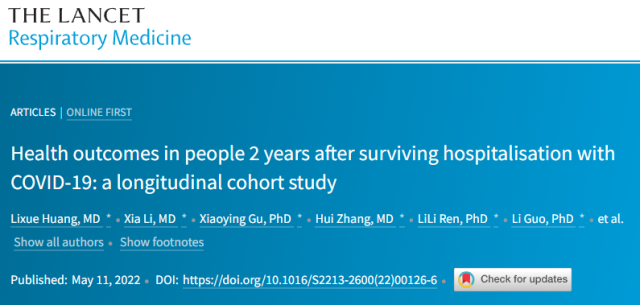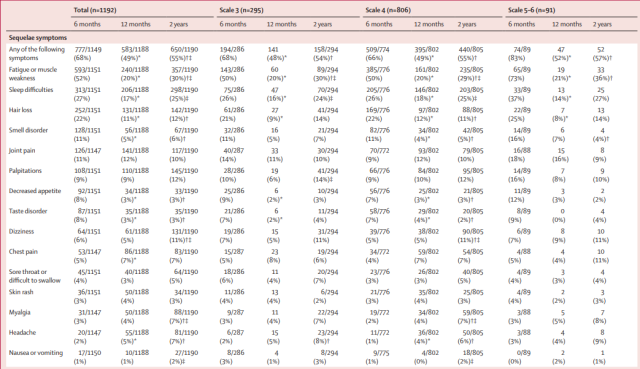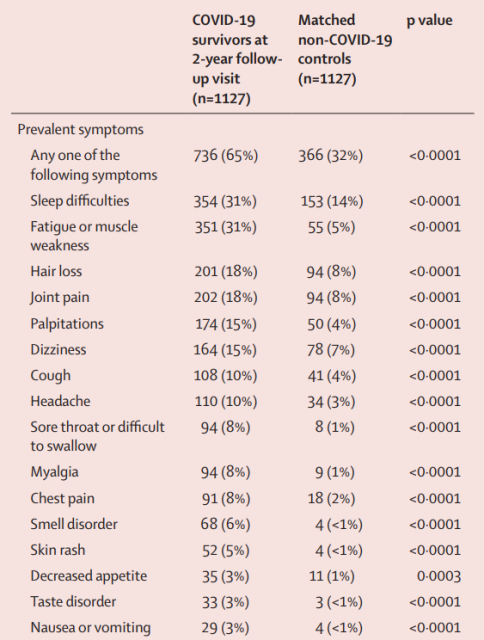Half people still have COVID sequelae even two years after discharge from hospital
- Normal Liver Cells Found to Promote Cancer Metastasis to the Liver
- Nearly 80% Complete Remission: Breakthrough in ADC Anti-Tumor Treatment
- Vaccination Against Common Diseases May Prevent Dementia!
- New Alzheimer’s Disease (AD) Diagnosis and Staging Criteria
- Breakthrough in Alzheimer’s Disease: New Nasal Spray Halts Cognitive Decline by Targeting Toxic Protein
- Can the Tap Water at the Paris Olympics be Drunk Directly?
Half people still have COVID sequelae even two years after discharge from hospital
- Should China be held legally responsible for the US’s $18 trillion COVID losses?
- CT Radiation Exposure Linked to Blood Cancer in Children and Adolescents
- FDA has mandated a top-level black box warning for all marketed CAR-T therapies
- Can people with high blood pressure eat peanuts?
- What is the difference between dopamine and dobutamine?
- How long can the patient live after heart stent surgery?
Half people still have COVID sequelae even two years after discharge from hospital.
The new coronavirus usually infects humans through the respiratory tract and causes damage to the respiratory system and various organs of the human body. S
ince the outbreak at the end of 2019, it is still raging around the world, causing great negative impact on the world economy and society.
More than two years after the epidemic, more and more evidence has shown that the COVID-19 is not just a respiratory disease, but affects multiple tissues and organs of the human body. For example, it leads to loss of smell and taste, fatigue, cognitive decline, and some patients also experience strokes and more severe symptoms of impaired consciousness, all of which are known as COVID-19 sequelae.
On May 11, 2022, Professor Cao Bin of China-Japan Friendship Hospital and Professor Wang Jianwei of Chinese Academy of Medical Sciences and Peking Union Medical College published a research paper online in “The Lancet Respiratory Medicine”, entitled: “Health outcomes in people 2 years after surviving hospitalisation with COVID-19: a longitudinal cohort study“.
This is the longest COVID-19 follow-up study to date. The research team tracked 1,192 hospitalized patients with COVID-19 at the initial stage of the pandemic and found that two years later, 55% of those recovered from COVID-19 still had at least one sequelae, including fatigue . , muscle weakness, difficulty breathing, difficulty sleeping, etc.
Overall, patients experienced longitudinal improvements in physical and mental health regardless of initial disease severity.
However, 55% of hospitalized patients still had sequelae. Two years later, the health status of these patients who recovered from the COVID-19 is still significantly lower than that of the general population.
The findings suggest that there is an urgent need to explore the pathogenesis of sequelae and develop effective interventions to reduce the risk of sequelae.

In the study, researchers conducted a two-way longitudinal cohort study of 1,192 inpatients discharged from Jinyintan Hospital in Wuhan, China between January 7 and May 29, 2020 , evaluating participants at 6 and 12 months after discharge. And two years of health status, and compared with the data set of 3383 people who have not been infected with the COVID-19, as a control, to determine the recovery status of patients for 2 years.
Assessments included a six-minute walk test, laboratory tests and questionnaires about symptoms, mental health, health-related quality of life, return to work, and use of medical services after discharge. To determine the negative impact of COVID-19 sequelae on quality of life, exercise capacity, mental health, and healthcare use.
At 6 months after discharge, 68% of participants reported at least one COVID-19 sequelae, the study showed. By two years, that number had dropped to 55%. Fatigue and muscle weakness were the most frequently reported symptoms, falling from 52% at six months to 30% at two years.
 6-month, 12-month and 2-year clinical outcomes
6-month, 12-month and 2-year clinical outcomes
Two years later, these Covid-19 recovered patients had worse overall health than the general population, with 31 percent of participants reporting fatigue or muscle weakness and 31 percent reporting trouble sleeping. The proportions of these symptoms were 5% and 14%, respectively, compared with the control group.
In addition, COVID-19 patients reported pain or discomfort (23%) and anxiety or depression (12%) more frequently on the quality of life questionnaire.
 After 2 years, compared with the quality of life in the control group
After 2 years, compared with the quality of life in the control group
An analysis of the mental health of COVID-19 patients found that after 2 years, 13% of patients showed symptoms of anxiety and 11% showed symptoms of depression.
Compared with the control group, the proportions were 3% and 1%, respectively.
In terms of health care use, 26% of COVID-19 patients reported outpatient visits, compared with 11% of the control group.
The hospitalization rate for Covid-19 patients was 17%, higher than the 10% in the control group.
Overall, the study showed that after two years, 55% of Covid-19 discharges still had sequelae after two years, and that Covid-19 patients had worse overall health than the general population, but all patients continued to improve in all respects, In particular, anxiety or depression fell from 23% at 6 months to 12% at 2 years.
Taken together, regardless of initial disease severity, patients experienced longitudinal improvements in their physical and mental health. However, 55% of hospitalized patients still had sequelae.
At 2 years, the health status of these COVID-19 recovered patients was significantly lower than that of the general population, and there is an urgent need to explore the pathogenesis of sequelae and develop effective interventions to reduce the risk of sequelae.
Note: It should be pointed out that this sequelae study is aimed at patients who were initially infected with the original strain of the new coronavirus, and the Omicron mutant strain is currently circulating , which is less pathogenic.
Reference :
https://doi.org/10.1016/S2213-2600(22)00126-6
Half people still have COVID sequelae even two years after discharge from hospital.
(source:internet, reference only)
Disclaimer of medicaltrend.org
Important Note: The information provided is for informational purposes only and should not be considered as medical advice.



